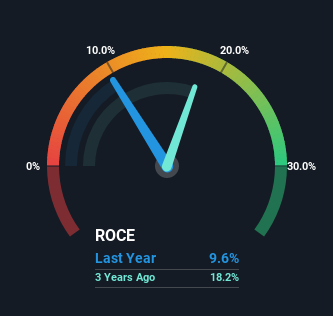Quixant (LON:QXT) Could Be Struggling To Allocate Capital
Finding a business that has the potential to grow substantially is not easy, but it is possible if we look at a few key financial metrics. Firstly, we'd want to identify a growing return on capital employed (ROCE) and then alongside that, an ever-increasing base of capital employed. Put simply, these types of businesses are compounding machines, meaning they are continually reinvesting their earnings at ever-higher rates of return. Although, when we looked at Quixant (LON:QXT), it didn't seem to tick all of these boxes.
What Is Return On Capital Employed (ROCE)?
For those that aren't sure what ROCE is, it measures the amount of pre-tax profits a company can generate from the capital employed in its business. The formula for this calculation on Quixant is:
Return on Capital Employed = Earnings Before Interest and Tax (EBIT) ÷ (Total Assets - Current Liabilities)
0.096 = US$6.4m ÷ (US$95m - US$28m) (Based on the trailing twelve months to June 2022).
Thus, Quixant has an ROCE of 9.6%. On its own that's a low return, but compared to the average of 7.9% generated by the Hospitality industry, it's much better.
View our latest analysis for Quixant
In the above chart we have measured Quixant's prior ROCE against its prior performance, but the future is arguably more important. If you'd like, you can check out the forecasts from the analysts covering Quixant here for free.
What The Trend Of ROCE Can Tell Us
When we looked at the ROCE trend at Quixant, we didn't gain much confidence. To be more specific, ROCE has fallen from 33% over the last five years. Although, given both revenue and the amount of assets employed in the business have increased, it could suggest the company is investing in growth, and the extra capital has led to a short-term reduction in ROCE. And if the increased capital generates additional returns, the business, and thus shareholders, will benefit in the long run.
What We Can Learn From Quixant's ROCE
In summary, despite lower returns in the short term, we're encouraged to see that Quixant is reinvesting for growth and has higher sales as a result. These growth trends haven't led to growth returns though, since the stock has fallen 60% over the last five years. So we think it'd be worthwhile to look further into this stock given the trends look encouraging.
If you're still interested in Quixant it's worth checking out our FREE intrinsic value approximation to see if it's trading at an attractive price in other respects.
While Quixant isn't earning the highest return, check out this free list of companies that are earning high returns on equity with solid balance sheets.
Have feedback on this article? Concerned about the content? Get in touch with us directly. Alternatively, email editorial-team (at) simplywallst.com.
This article by Simply Wall St is general in nature. We provide commentary based on historical data and analyst forecasts only using an unbiased methodology and our articles are not intended to be financial advice. It does not constitute a recommendation to buy or sell any stock, and does not take account of your objectives, or your financial situation. We aim to bring you long-term focused analysis driven by fundamental data. Note that our analysis may not factor in the latest price-sensitive company announcements or qualitative material. Simply Wall St has no position in any stocks mentioned.
Join A Paid User Research Session
You’ll receive a US$30 Amazon Gift card for 1 hour of your time while helping us build better investing tools for the individual investors like yourself. Sign up here

